Eastern Ribbon Snakes (Thamnophis sauritus)
Meet the Eastern Ribbon Snake (Thamnophis sauritus)! These slender and semi-aquatic snakes are easily identifiable by their distinctive yellow stripes that run along their bodies.
But, there’s much more to these fascinating creatures than just their beautiful appearance. In this article, we’ll delve deeper into their habitat, behavior, conservation status, and other interesting facts about the Eastern Ribbon Snake.
| Scientific Name: | Thamnophis sauritus |
| Family: | Colubridae |
| Type: | Reptile |
| Order: | Squamata |
| Temperament: | Docile |
| Lifespan: | Up to 6 years |
| Size: | 46.0 to 86.2 cm 18.11 to 33.94 in |
| Weight: | Up to 150 grams |
| Diet: | Carnivore |
| Distribution: | North America |
| Habitat: | Wetlands, grasslands, forests, and woodland edges |
| Other common names: | Eastern Ribbonsnake |
Description
The Eastern Ribbon Snake is a sleek, elongated serpent that can reach up to 28 inches in length. Its distinguishing features are three bright yellow stripes that run the length of its body, separated by a brown stripe, with a matching yellow stripe along its spine. The snake’s belly is also marked with the same yellow hue.
Unlike the Eastern Garter Snake, which it is often mistaken for, the Ribbon Snake has smooth, unpatterned scales on its lips.
Additionally, the lateral stripes of the Ribbon Snake are located on scale rows 3 and 4. Overall, the Eastern Ribbon Snake is a beautiful and unique species that stands out among its fellow reptiles.
Geographic Range of the Eastern Ribbon Snake
The Eastern ribbon snake is a native species of North America and is distributed across a wide range of land extending from southern Maine in the northeast to eastern Louisiana in the southwest.
They can be found throughout much of eastern North America east of the Mississippi River, including southern Ontario, Michigan, the Gulf states, and along the eastern seaboard.
However, their distribution is not uniform, and there are regions where Eastern ribbon snakes are less common.
They are largely absent from southern Ohio, southeastern Illinois, central Pennsylvania, West Virginia, Kentucky, Tennessee, and northern Alabama and Georgia. Nonetheless, isolated populations of Eastern ribbon snakes can be found in some parts of Kentucky and Wisconsin.
Eastern ribbon snakes typically inhabit semi-aquatic habitats, such as the edges of lakes, bogs, and salt marshes, in the regions where they are prevalent.
Interestingly, these snakes are found throughout the eastern US, except for the Appalachian Mountains. In our region, they are commonly found in the Piedmont and Coastal Plain, but become more abundant from the Mountains to the Coast.
The habitat preferences of the Eastern Ribbon Snake:
| Habitat Regions | Terrestrial Biomes | Aquatic Biomes | Wetlands | Other Habitat Features |
|---|---|---|---|---|
| Temperate Terrestrial | Savannah or Grassland | Lakes and Ponds, Rivers and Streams | Marsh, Swamp | Suburban, Agricultural, Riparian |
Habits of Eastern Ribbon Snake
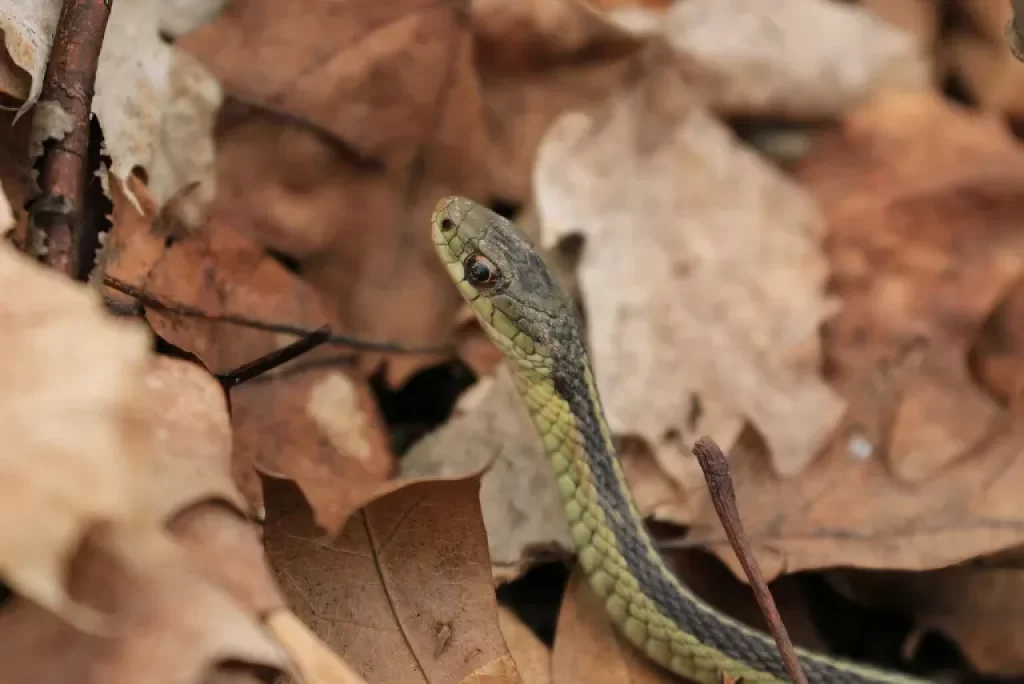
The Eastern Ribbon Snake is typically found in wetland habitats such as wet meadows and fields that are located near the edges of lakes, ponds, streams, and marshes.
These snakes are particularly drawn to areas that receive plenty of sunlight, as they require warmth to regulate their body temperature. They are well adapted to living in temperate terrestrial environments and can be found in savannas or grasslands, as well as suburban and agricultural areas that are near riparian zones.
The Ribbon Snake’s ability to thrive in both aquatic and terrestrial biomes makes it a versatile and adaptable species.
Breeding and Reproduction of the Eastern Ribbon Snake
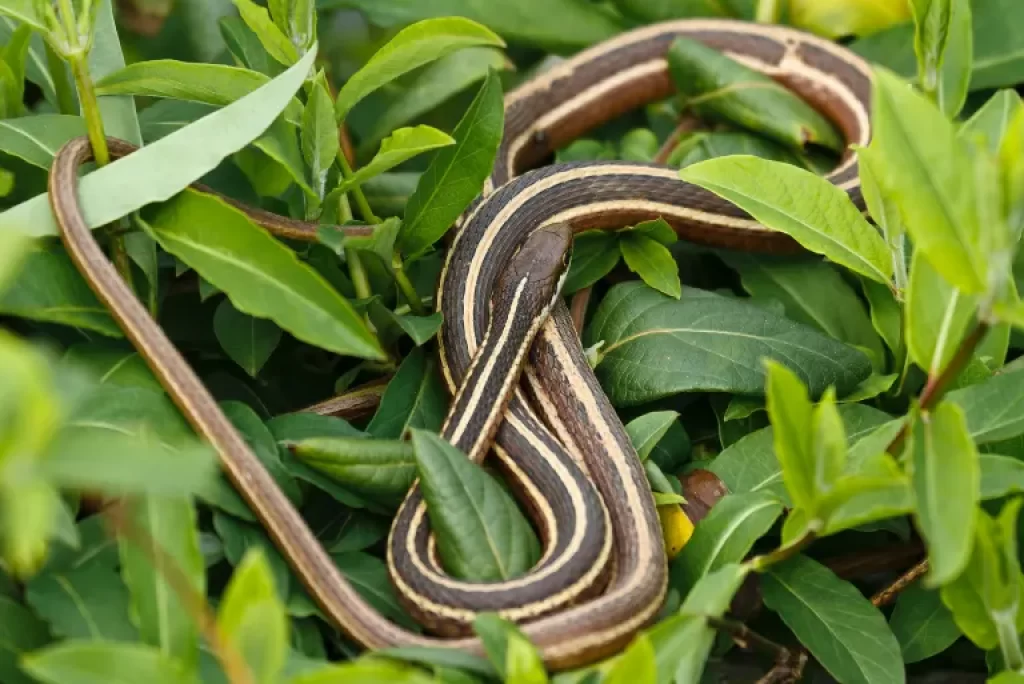
The Eastern Ribbon Snake follows a polygynandrous mating system, where both males and females mate with multiple partners during a breeding season.
Mating typically occurs in the spring soon after emerging from hibernation, but can also occur in the fall. During courtship, males seek out females and attempt to mate with them.
Female Ribbon Snakes give birth to live young in late summer, and litter sizes can range from 4 to 27 offspring, with an average of 12. The young snakes grow rapidly and can often reach sexual maturity before their second year, although some females may not breed until their third year.
Ribbon Snakes are ovoviviparous, which means that the eggs develop inside the female’s body and hatch within her, with the offspring being born live.
The parents provide no parental care after the young are born, and the offspring are fully independent and self-sufficient from birth.
Breeding Interval:
- Eastern Ribbon Snakes breed once or twice yearly.
Breeding Season:
- The breeding season for Eastern Ribbon Snakes typically occurs in the spring soon after they emerge from hibernation, but mating can also occur in the fall.
- Female Ribbon Snakes give birth to live young in late summer, usually in August or September.
Litter Size:
- The litter size of the Eastern Ribbon Snake ranges from 4 to 27 offspring, with an average of 12.
- However the average litter size is 14.
Parental Care:
- The young Eastern Ribbon Snakes are nurtured inside of their mother’s body until they are born.
- Once the offspring are born, there is no further parental care provided by the parents.
Age at Sexual Maturity:
- Eastern Ribbon Snakes reach sexual maturity at an age range of 1 to 3 years for both males and females.
- Some females may not breed until their third year.
Communication and Perception in Eastern Ribbon Snakes
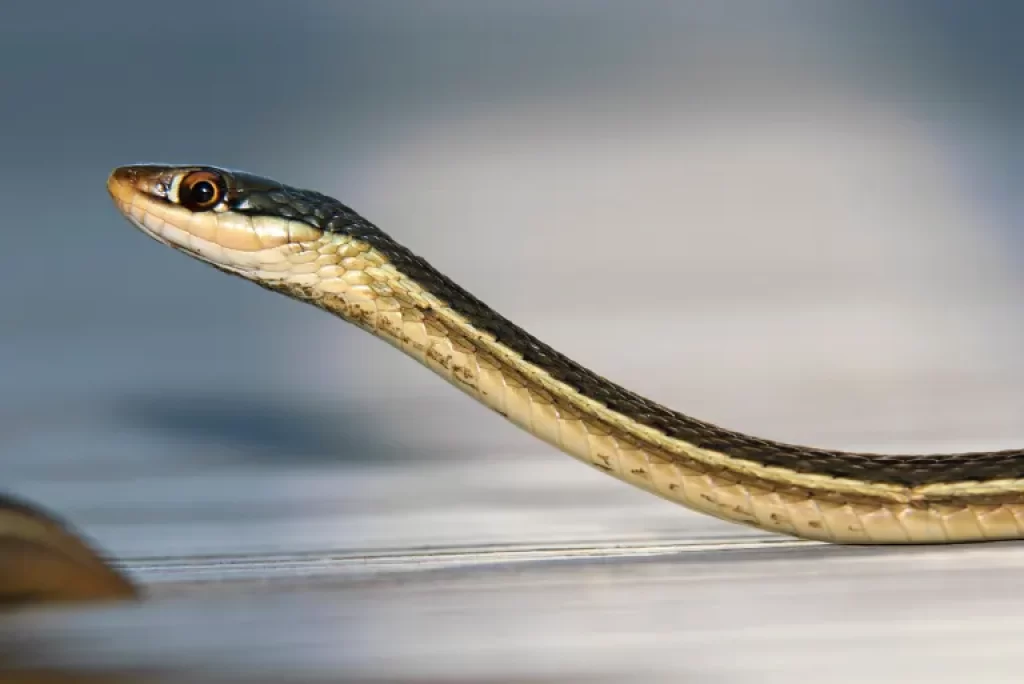
Sense of Smell:
- Eastern Ribbon Snakes primarily communicate with each other through smell.
- They use their forked tongues to collect chemicals from the air, and then insert these forks into a special organ in the roof of their mouth called the Jacobson’s organ.
- The Jacobson’s organ interprets these chemical signals and helps the snakes identify potential mates and prey.
Sense of Touch:
- Eastern Ribbon Snakes also use touch to communicate with each other.
- They are sensitive to vibrations and use this sense to detect the movement of prey and predators.
Vision
- Although Eastern Ribbon Snakes primarily rely on their sense of smell and touch, they also have reasonably good vision.
- They are able to detect movement and shapes, which helps them navigate their environment and identify potential threats.
Overall, Eastern Ribbon Snakes use a combination of their sense of smell, touch, and vision to perceive their environment and communicate with other snakes.
Predation in Eastern Ribbon Snakes
Eastern Ribbon Snakes are preyed upon by a variety of predators in their habitat, including:
- Great blue herons
- Hawks
- Mink
- Raccoons
- Large fish
- Bullfrogs
Young snakes are particularly vulnerable to predation by large fish and bullfrogs.
Escape strategies:
- Eastern Ribbon Snakes use a combination of speed and agility to escape predators.
- They readily flee into the water, where they may dive and hide below the surface or into dense vegetation.
- When threatened, they will flatten their heads and bite at the attacker.
- They will also thrash their bodies violently and smear the attacker with a foul-smelling secretion to deter them.
Eastern Ribbon Snakes have a variety of predators in their habitat and have developed several strategies to escape from them, including their speed and agility, hiding in vegetation or underwater, and using defensive behaviors like biting and secreting a foul-smelling substance.
Similar Species
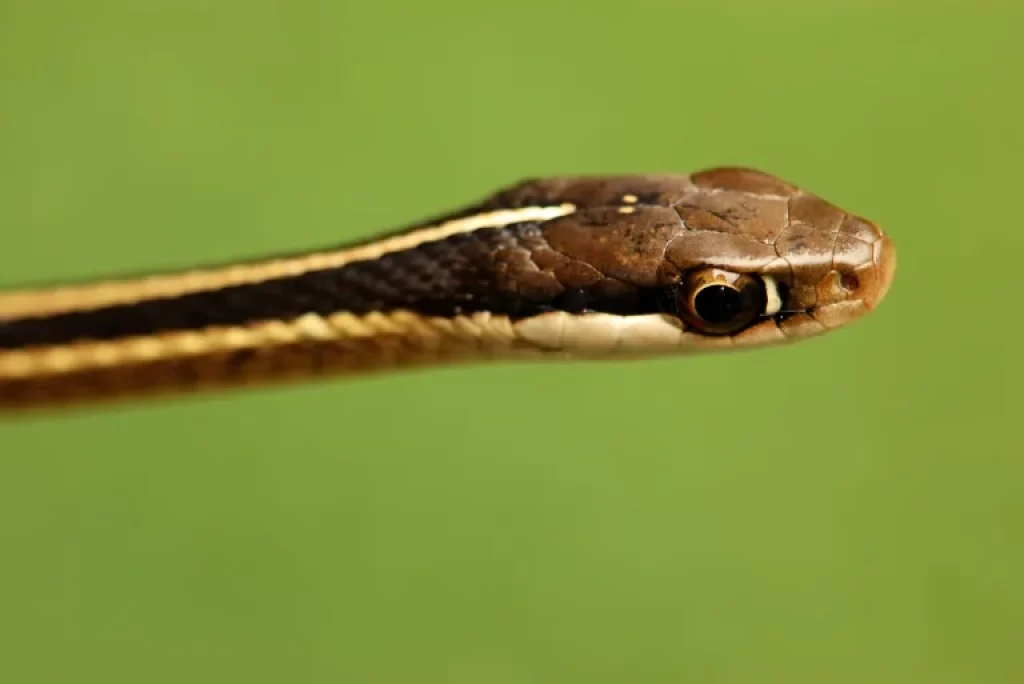
The eastern ribbonsnake has several similar species, including the eastern gartersnake, Butler’s gartersnake, and red-sided gartersnake. However, there are some notable differences that distinguish the eastern ribbonsnake from these species.
Firstly, the eastern ribbonsnake has a distinct white crescent in front of the eye, while the other species lack this feature.
Additionally, the chin of the eastern ribbonsnake is more white than yellow, and the transition between the light-coloured chin and the dark head is more defined compared to the other species. The eastern ribbonsnake is also more slender and has a longer tail.
The lateral stripes on the eastern gartersnake are confined to the second and third scale rows, while the Butler’s gartersnake has lateral stripes on the third and part of the second and fourth scale rows. The red-sided gartersnake is only found in northwestern Ontario.
It’s worth noting that the eastern ribbonsnake may be confused with the queensnake due to their similar yellowish lateral stripes. However, the queensnake has several faint dark stripes rather than a yellow stripe down the back.
What is the difference between ribbon and garter snakes?
Ribbon snakes and garter snakes are both members of the genus Thamnophis and are similar in appearance, but there are some differences between the two.
Ribbon snakes are typically longer and more slender than garter snakes, with a longer tail relative to their body size.
They also tend to have more contrasting and defined lateral stripes than garter snakes, and often have a white or yellowish stripe down the middle of their back.
In addition, ribbon snakes are more likely to be found near water, as they are semi-aquatic and are known for their swimming ability.
Garter snakes, on the other hand, are more adaptable to a variety of habitats, including grasslands, forests, and wetlands.
They have a wider range of color and pattern variations than ribbon snakes, and their stripes are often less distinct.
Why is a ribbon snake called a ribbon snake?
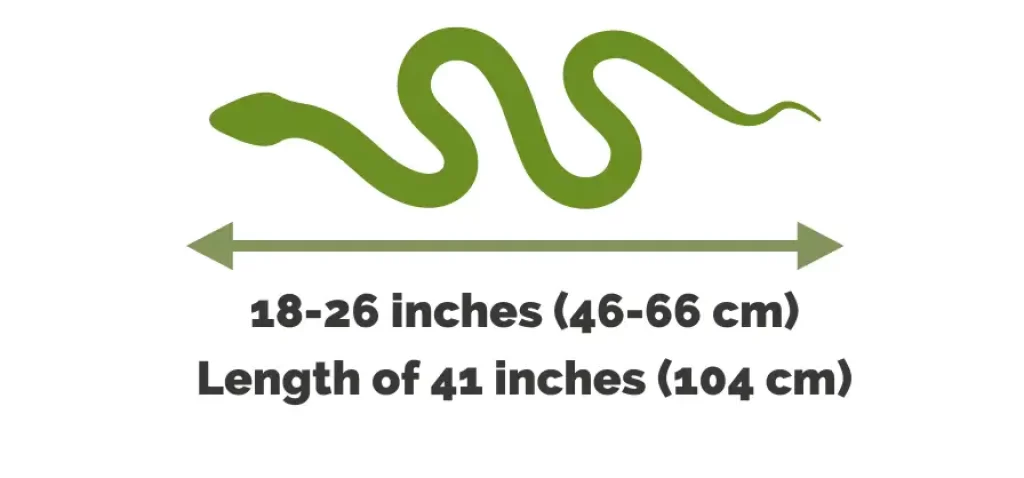
The name “ribbon snake” refers to the distinct pattern on the dorsal side of the snake’s body, which resembles a ribbon. The three long, thin stripes that run along the length of the snake’s body give it a ribbon-like appearance, hence the name.
The stripes are usually yellow or cream-colored and are separated by a darker green or brown color. This unique pattern helps the ribbon snake to camouflage itself in its natural environment, making it easier to catch prey and avoid predators.
How poisonous is a ribbon snake?
Ribbon snakes, including the Eastern ribbon snake, are not venomous and do not produce any toxic secretions. They are harmless to humans and pose no threat to human health. Ribbon snakes use their speed and agility to escape predators rather than relying on venom or other defensive mechanisms.
Can you handle a ribbon snake?
While ribbon snakes are generally not aggressive and may try to flee when approached by humans, it is not recommended to handle them.
Like all wild animals, they can bite if they feel threatened or cornered, and their bite can potentially cause harm to humans.
Additionally, handling snakes can be stressful for them and may harm their health. If you come across a ribbon snake in the wild, it’s best to observe it from a safe distance and allow it to continue its activities without disturbance.
Conservation Status of Eastern Ribbon Snakes
Despite being a common species in our region, Eastern Ribbon Snakes are protected throughout the state of Georgia. It’s essential to protect their habitats to ensure the survival of this species in the wild.
Final thoughts

The eastern ribbon snake is a remarkable and intriguing snake species that inhabits eastern North America. Its striking coloration, slender physique, and aquatic nature make it a remarkable and essential species in the ecosystem. However, the eastern ribbon snake faces a threat from habitat loss and fragmentation.
Therefore, conservation and protection measures are crucial to safeguard this species for future generations. If you have any questions or comments regarding the eastern ribbon snake or our content, please leave a comment below.
Also, feel free to share this information with others to raise awareness about the importance of preserving this species. 😊
Eastern Ribbon Snakes FAQ
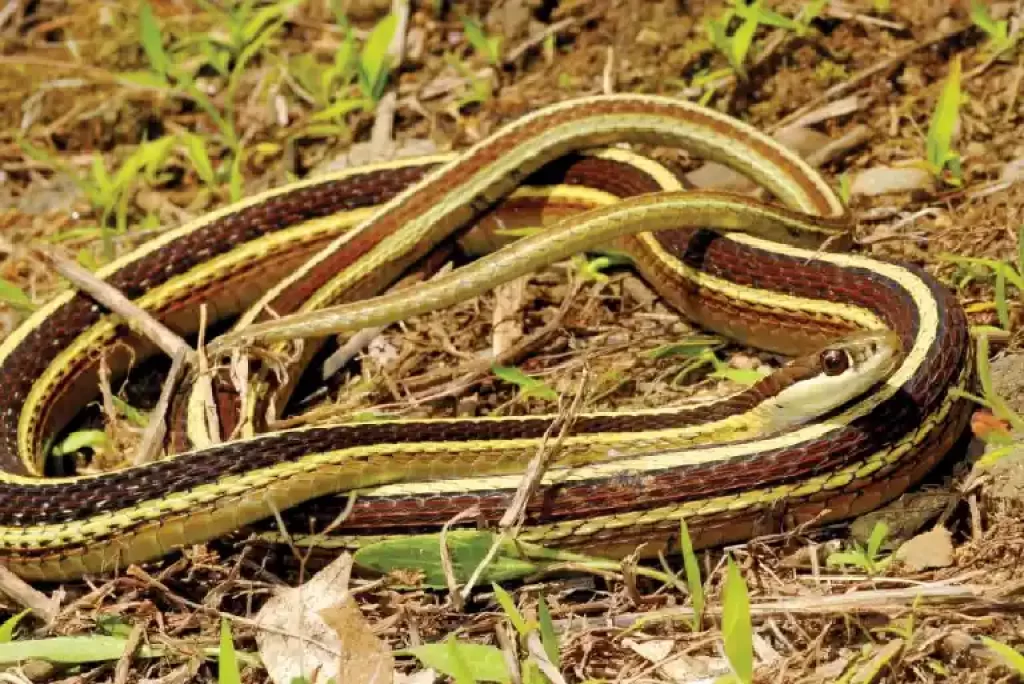
How long do ribbon snakes live?
Eastern ribbon snakes typically live for 4-5 years in the wild, although they can live up to 10 years in captivity with proper care.
Are ribbon snakes poisonous to dogs?
Ribbon snakes are not considered venomous or poisonous to dogs. However, if a dog were to bite or ingest a ribbon snake, it could potentially cause harm to the snake and/or the dog. It is always best to keep pets away from wild animals to prevent any potential harm to either the pet or the animal.
What does a ribbon snake Eat?
The ribbon snake is known to have a diverse diet, primarily consisting of aquatic animals such as frogs, toads, salamanders, and tadpoles. Additionally, small fish and various invertebrates such as insects and crayfish may also be on the menu.
Despite being a relatively small predator, ribbon snakes themselves are not immune to predation, and can fall prey to a range of animals including birds, mammals, fish, and large amphibians.







